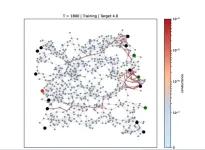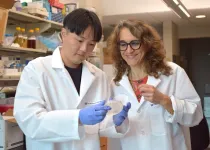(Press-News.org) There’s a crisis unfolding in the field of linguistics: Global language experts estimate that, without intervention, about one language will be lost every month for the next 40 years.
A study published in Science Advances debuts a grammatical database that documents the enormous diversity of current languages on the planet, highlighting just how much humanity stands to lose and why it's worth saving.
Known as Grambank, it is now the world’s largest publicly available comparative grammatical database. Initiated by scholars in the Department of Linguistic and Cultural Evolution at the Max Planck Institute for Evolutionary Anthropology in Leipzig, Germany, more than 100 authors from 68 institutions, including the University of Colorado Boulder, contributed to the years-long, global data project.
The analysis of more than 400,000 data points and 2,400 separate languages and dialects reveals that language loss is occurring unevenly across major linguistic regions of the world, with indigenous languages in northeast South America, Alaska to Oregon, and in northern Australia at highest risk.
“Grambank is showing us the importance of working on language documentation and revitalization in order to preserve this legacy of human communication, culture and cognition,” said Hannah Haynie, co-first author of the study and assistant professor in the Department of Linguistics at CU Boulder.
Grammar 101
Grammar is simply the rules of a language: the words and sounds used, and how they are combined and interpreted. Grammatical elements of a language include word order (if the subject goes before or after the verb), tense (present, the past or future), comparatives (words that express ‘bigger’ or ‘smaller’) and whether a language has gendered pronouns.
Over the past century, many researchers have studied languages, worked with their speakers, and published books or other types of grammatical descriptions of languages. Grambank is built both on these research analyses and prior language databases, but compared with previous databases, it is larger in scale and more thorough. It encodes 195 possible grammatical features for about 215 language families.
“Our understanding of grammar and what that tells us about humans is limited by what we can observe,” said Haynie. “We're putting those observations into this data set, and that allows for comparison.”
As there are currently about 4,300 languages with published grammatical descriptions—out of about 7,000 known languages in the modern world—Grambank is over halfway to encoding all possible grammar information that can be extracted from existing data sources, said Haynie.
“Unusual” languages
Using Grambank, the team found that they could identify “unusual” languages: those which stray further from the averages in variation typically found in language, which often have no known sister languages. But they also found that there’s nothing particularly unusual about endangered languages compared with those that are not endangered.
“A lot of fairly ordinary languages, in terms of their basic grammar, happen to be endangered for a variety of reasons,” said Haynie.
English, spoken around the world by 1.5 billion people, is actually “a pretty weird language” by Grambank’s standards.
“Some of the places with more ‘unusual’ languages are places like Europe and Northern Africa—languages that we, as English speakers, tend to be more familiar with,” said Haynie.
The bigger takeaway for Haynie is that none of the languages in the dataset are identical. Of all 2,400 languages and dialects in the dataset, only five match up the same using the grammatical code used to document and analyze them within Grambank. Though vocabulary may play a big role in the mutual unintelligibility that linguists rely on to determine what counts as separate languages, Grambank shows that the grammatical ‘fingerprints’ of languages are also typically unique, she said.
“It means that every language is pretty darn special,” said Haynie.
Language loss
Language extinction has occurred throughout human history, but its speed has been accelerating due to social, political and economic pressures, said Haynie.
It’s as if, while mapping the human genome, scientists saw the genes themselves rapidly disappearing before their eyes.
“Right now we're at a critical state, in terms of language endangerment,” said Haynie, noting that the United Nations has declared this the International Decade of Indigenous Languages to try to promote language preservation, documentation and revitalization.
This global language loss is also not evenly distributed. Several regions are at higher risk of losing indigenous languages, such as Aleut in Alaska and Salish languages of the Pacific Northwest, Yagua and Tariana spoken in South America, and the languages of Kuuk-Thayorre and Wardaman native to Northern Australian communities.
“Indigenous languages here in North America, languages around us and on our continent, are some of the most endangered languages in the world,” she said.
Genealogy versus geography
One element that has been “hotly debated” within linguistics for years is the relationship between genealogy and geography in the development of language. That is: Which features in language are inherited from family and culture (genealogy) and which are more likely to be shared through contact among neighbors (geography)?
The Grambank analysis found that genealogy seems to be consistently more important than geography—meaning that the faithful inheritance of ancestral language plays a stronger role in shaping grammar in languages still spoken today than who someone’s geographical neighbors were and how they talked, said Haynie.
While language crossover and bilingualism are well documented throughout history, this finding showcases how there is much we can still learn about human history and the ways we communicate in present day from the words of our ancestors.
“Language always finds a way,” said Haynie.
The Grambank database is an open-access comprehensive resource maintained by the Max Planck Society.
END
World’s largest grammar database reveals accelerating loss of language diversity
2023-04-21
ELSE PRESS RELEASES FROM THIS DATE:
Study points to new approach to treat chronic transplant rejection
2023-04-21
University of Pittsburgh researchers have identified a type of immune cell that drives chronic organ transplant failure in a mouse model of kidney transplantation and uncovered pathways that could be therapeutically targeted to improve patient outcomes. The findings are published in a new Science Immunology paper.
“In solid organ transplantation, such as kidney transplants, one-year outcomes are excellent because we have immunosuppressant drugs that manage the problem of acute rejection,” ...
Cheaper method for making woven displays and smart fabrics – of any size or shape
2023-04-21
Researchers have developed next-generation smart textiles – incorporating LEDs, sensors, energy harvesting, and storage – that can be produced inexpensively, in any shape or size, using the same machines used to make the clothing we wear every day.
The international team, led by the University of Cambridge, have previously demonstrated that woven displays can be made at large sizes, but these earlier examples were made using specialised manual laboratory equipment. Other smart textiles can be manufactured in specialised microelectronic fabrication facilities, but these are highly expensive and produce large volumes of waste.
However, the team found that flexible ...
Researchers devise cascaded microfluidic circuits for pulsatile filtration of extracellular vesicles directly from whole blood samples
2023-04-21
Extracellular vesicles (EVs) are cell-secreted lipid bilayer bioparticles with a diameter of 30 to 250 nm. They are a promising source of biomarkers for liquid biopsies for early cancer diagnosis and real-time monitoring of tumor development. However, analysis of nanosized EVs in blood samples has been hampered by the lack of effective, rapid, and standardized methods to isolate and purify EVs.
In a study published in Science Advances, SUN Jiashu’s group from the National Center for Nanoscience and Technology (NCNST) of the Chinese Academy of Sciences (CAS) and collaborators from the Fifth Medical Center of the Chinese PLA General ...
Nanowire networks learn and remember like a human brain
2023-04-21
An international team led by scientists at the University of Sydney has demonstrated nanowire networks can exhibit both short- and long-term memory like the human brain.
The research has been published today in the journal Science Advances, led by Dr Alon Loeffler, who received his PhD in the School of Physics, with collaborators in Japan.
“In this research we found higher-order cognitive function, which we normally associate with the human brain, can be emulated in non-biological hardware,” Dr Loeffler said.
“This work builds on our previous research in which we showed how nanotechnology could be used to build a brain-inspired electrical device with neural ...
Long distance voyaging among the Pacific Islands
2023-04-21
Polynesian peoples are renowned for their advanced sailing technology and for reaching the most remote islands on the planet centuries before the Europeans reached the Americas. Through swift eastward migrations that are now well covered by archaeological research, Polynesian societies settled virtually every island from Samoa and Tonga to Rapa Nui/Easter Island in the east, Hawai’i in the north, and Aotearoa/New Zealand in the south. But little is known about Polynesian migrations west of the 180th meridian.
In order to better understand the relationship between these Polynesian societies of the western Pacific, Melanesia and Micronesia – often ...
Heart injury biomarker may help COVID-19 patients avoid hospitalization, new study shows
2023-04-21
A study led by the University of St Andrews suggests that a frequently used medical test for heart injury could one day be used to help COVID-19 patients avoid hospitalisation.
Cardiac troponins are proteins that form part of the heart’s contractile machinery and are released into the bloodstream when the heart is damaged. It can be measured in a blood test which is widely used in the assessment of heart attacks and other heart conditions.
Existing studies since 2020 have shown that COVID-19 patients who have elevated troponin levels are more likely to die or suffer adverse clinical outcomes compared with those who have normal ...
Study: Cells send maintenance crews to fix damaged protein factories
2023-04-21
JUPITER, Fla. — In a discovery fundamental to the inner workings of cells, scientists have discovered that if oxidative stress damages protein factories called ribosomes, repair crews may move in to help fix the damage so work can quickly resume.
The discovery, reported Friday in the journal Molecular Cell, could have implications for cancer, the aging process, and growth and development, said the study’s lead author, molecular biologist Katrin Karbstein, Ph.D., a professor at The Herbert ...
New stellar danger to planets identified by NASA'S Chandra program
2023-04-21
CHAMPAIGN, Ill. — An exploded star can pose more risks to nearby planets than previously thought, according to a new study from NASA’s Chandra X-ray Observatory and other X-ray telescopes. This newly identified threat involves a phase of intense X-rays that can damage the atmospheres of planets up to 160 light-years away.
The results of the study, led by researchers at the University of Illinois Urbana-Champaign, Washburn University and the University of Kansas, are published in the Astrophysical Journal.
Earth is not in danger of such a threat today because there are no potential supernova progenitors within this distance, but it may have experienced ...
Why are COVID-19 vaccination rates among children so low? Parents’ worry about long-term risks, responsibility
2023-04-21
Despite efforts by the U.S. Centers for Disease Control and Prevention and pediatric clinicians to increase the COVID-19 vaccination rate among children, many remain unvaccinated due to parental concerns about the vaccine’s long-term effects and anticipated responsibility. Those are findings from a new study published in Pediatricsand conducted by the Center for Economic and Social Research(CESR) at the USC Dornsife College of Letters, Arts and Sciences.
The researchers sought to determine the causes of low child vaccination rates. Currently, only 39% of children 5 to 11 and 68% of those 12 to 17 have received ...
Insignum AgTech and Beck’s collaborate to help corn ‘talk’
2023-04-21
ATLANTA, Ind. – Insignum AgTech® and Beck’s have signed an agreement to test Insignum’s innovative corn traits in Beck’s elite varieties. The companies will collaborate to cross the trait into proprietary Beck’s genetics for field-testing in 2023 to evaluate commercial viability of the traits.
Insignum AgTech develops plant genetic traits that enable plants to “talk” and signal to farmers when specific plant stresses begin.
“With this trait, a corn plant generates purple pigment, indicating that a fungal infection has started ...






